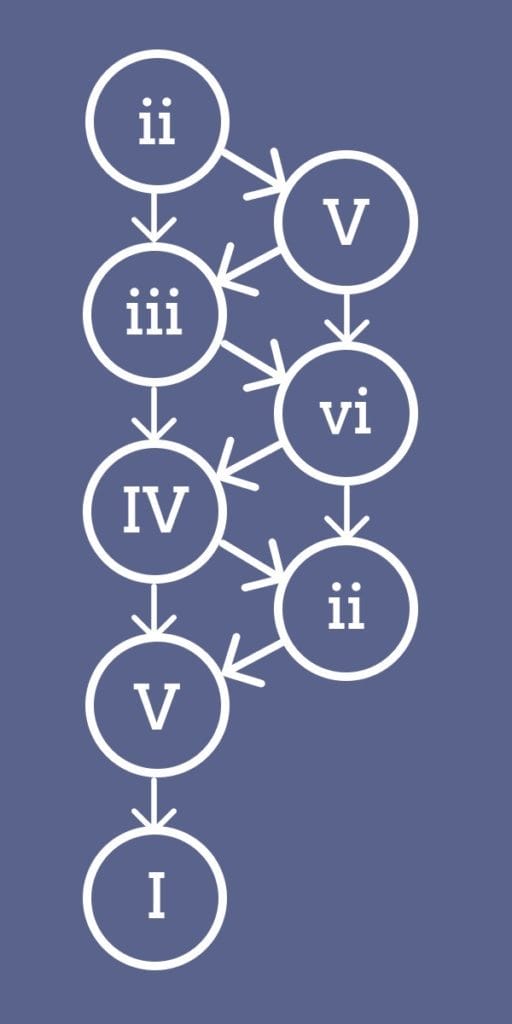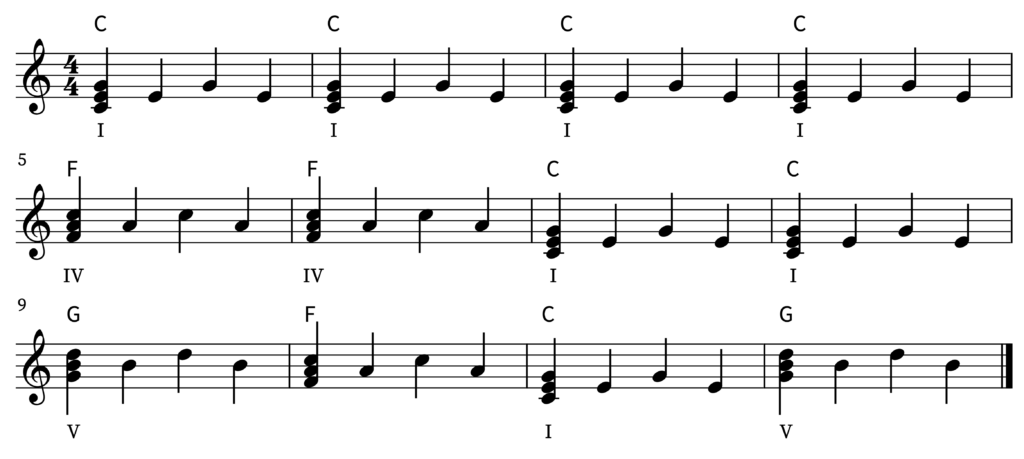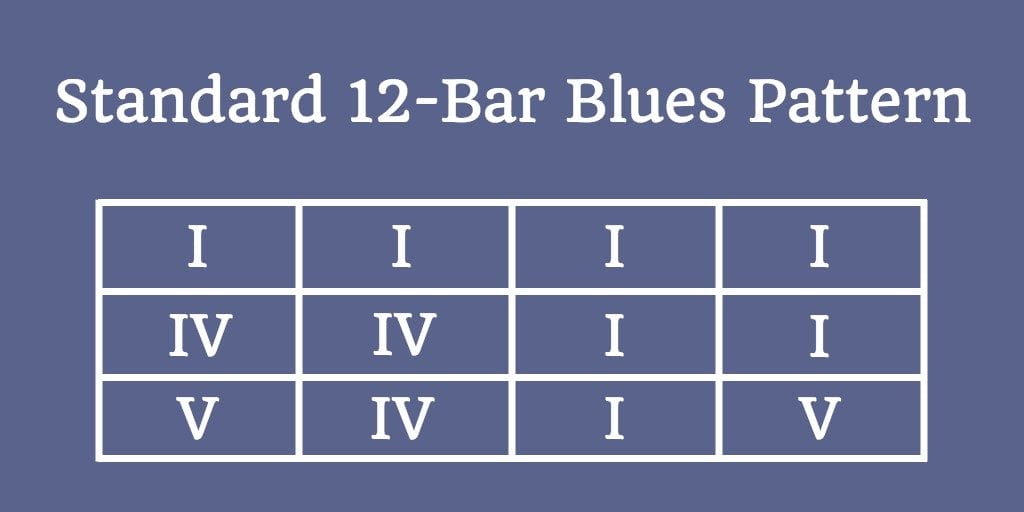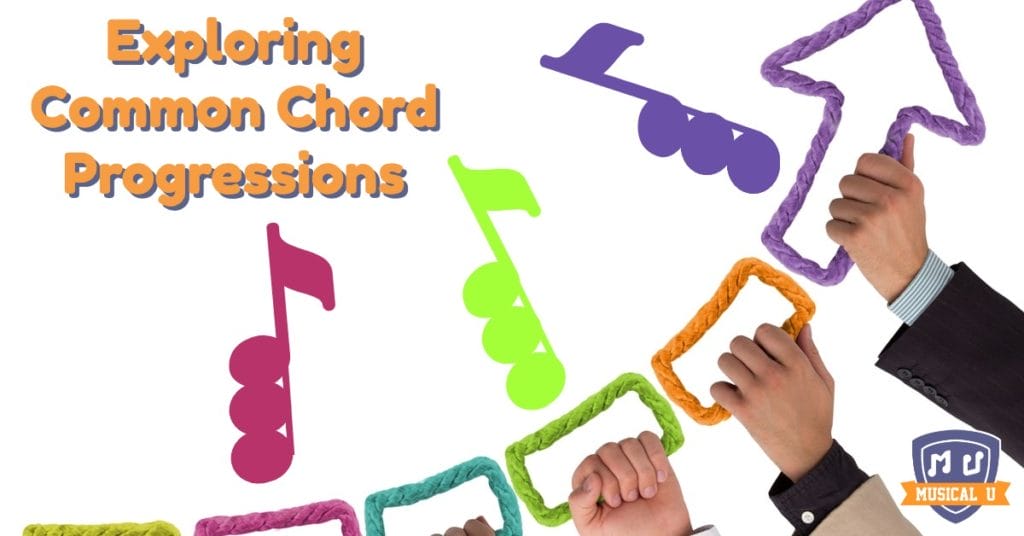Harmony in Western music would not exist without chord progressions – much of Western music, especially pop, rock, blues, jazz, and classical, is built on sequences of chords.
Creating a chord progression may be easy, but not all chord combinations sound good together, and if you created one at random, it’s unlikely that it would sound memorable or satisfying.
If you’re trying to write the “perfect” chord progression, bad news – someone has beat you to it, and countless other someones have written songs based around this earworm of a chord progression:
This particular progression is known as the I – V – vi – IV, and it’s no accident that thousands of songwriters have used it to great effect – it’s been described as a progression that sounds satisfying, hopeful, complete, and sentimental.
It turns out, there’s a whole stack of these common chord progressions that gained their fame through their strong sense of purpose, direction, and resolution.
Stay with us as we take you through a bit of theory to explain where these chords come from, look at the most popular ways in which they’re strung together, and explore how you can use these progressions to write your own unique tune without falling into the trap of music cliché.
Table of Contents
2. What makes a chord progression sound good?
4. Transposing Chord Progressions
5. What makes songs with the same progression sound different?
6. Writing Songs with Common Chord Progressions
7. One Chord In Front of the Other
A Bit of Theory
We know that some chords sound good together, and some… not so much.
So why do some chord progressions pop and others flop?
Scales and Chords
To understand this phenomenon, we turn to the scale.
Every major and minor scale has seven pitches, and a chord can be built on each of the seven pitches. These chords are known as diatonic chords, and can be thought of as a family of chords belonging to one key.
Each of these chords follows the key signature of the key, and therefore there is a lot of note overlap – every chord uses three out of a possible seven notes, which means that these seven chords tend to sound pretty good together.
We can name these seven chords by using numbers:

Naming Progressions
As you may have figured out, naming a progression is as simple as stringing together the numerals representing the chords you’re playing.
Here’s a ii – V – I in C major:

Now that we understand where chords come from and how we name them, let’s look at how they’re often strung together. If you’re looking to absorb a bit more theory on the matter, Spread Worship has an excellent primer on scale degrees and chord nomenclature.
What makes a chord progression sound good?
If we consider songwriting to be telling a story with music, then the order and selection of chords matters just as much as what words you put where – the order and context of the chords can mean the difference between a strong musical statement and a forgettable phrase.
A Path to Resolution
The chord built on the first degree of the scale, or the tonic (I) chord, functions as “home base”, or the resting place, of the key. As you’re about to see, many progressions get their power from creating a path to resolution to the tonic.
If we’re thinking about it in terms of a story, we can create a chord progression that follows a sequence of stability – departure – tension – resolution – stability, with “stability” of course representing the tonic.
The dissonance and suspense that a good chord progression will create relies on strategic movement away from and towards the tonic.
How do we know what chords will sound good after the tonic? How about the chords that will sound good right before a tonic?
A Natural Order
As it turns out, some chords naturally “pull” towards others. Understanding precisely why this happens is beyond the scope of this discussion. If you want to go deeper into how this pull works, look into The Circle of Fifths. Otherwise, let’s acknowledge the fact that some chords sound “natural” and “more right” after others, and let our ears confirm it.
Though of course there are infinite ways in which you could place chords in front of one another, this chart conveniently summarizes the pathways you can use to build the strongest progressions:

As we’re about to see, the most common chord progressions follow this chart almost to a tee.
Popular Chord Progressions
Without further ado, let’s dive into the tried-and-true chord sequences that have wormed their way into thousands of songs and millions of ears. We’ll include a little cheat sheet for each one with the corresponding chords in each key, for easy playing.
The Popular Kid: I-IV-V Progression
The I, IV, and V chords, respectively called the tonic, the subdominant, and the dominant chords, are the strongest chords. Together, they form a trinity with which countless hits have been written.
This progression is the poster child of that “resolution” our ear seeks out in chord progressions. We begin at the tonic, move away from “home” with the IV (subdominant) chord, create tension with the V (dominant chord), and finally resolve back to the I chord.
Pro tip for songwriters: This progression works especially well in uptempo country, pop, and rock songs – think the Beatles and the Ramones. If you’re trying to write a catchy, high-energy tune, this progression is a good way to go.
Give it a listen:

It’s impossible to navigate the world of Western music without bumping into this progression. It shows its face in rock, pop, country, Blues, classical, and jazz. It sounds incredibly pleasing to the ear, and you’d be hard-pressed to find a more harmonically solid sequence of chords.
I – IV – V in every key:
C major: C-F-G
D♭ major: D♭-G♭-A♭
D major: D-G-A
E♭ major: E♭-A♭-B♭
E major: E-A-B
F major: F-B♭-C
F♯ major: F♯-A♯-C
G major: G-C-D
A♭ major: A♭-D♭-E♭
A major: A-D-E
B♭ major: B♭-E♭-F
B major: B-E-F♯
The I-IV-V is important for another reason: a slight variation on this progression forms the backbone of one of the most influential styles Western music has seen…
The 12-Bar Blues
Whether the blues song you’re listening to is about loneliness, a cheating wife, or an empty wallet, there’s a high chance the chord progression behind the words looks a little something like this:

The progression can be illustrated as follows:

Though there’s a return to the I chord after the IV, there is tension built up through this “incomplete” return, which is resolved at the end of the pattern once the progression returns to the I chord at the start of the first bar.
The history of this progression is deep and fascinating, and its uses are not limited to strictly blues music! Learn all about the origins of the blues and the uses of the progression with 2 Minute Guitar.
This may be the most popular iteration of the 12-bar blues, but it’s not the only one – Guitar Chord showcases some fascinating spins on the classic progression, including a blues jazz progression and a minor 12-bar progression. If you’d rather stick with the original, Fredrik Hertzberg shows you how to change the groove of the blues progression with some tiny tweaks.
The Sensitive One: I – V – vi – IV Progression
Take the I – IV – V progression, shuffle the order a bit, introduce the minor vi chord, and you get the I – V – vi – IV progression. This added chord brings with it a layer of emotional complexity and depth.
This progression gives you a bit more leeway than the I – IV – V in terms of writing vocal lines – the progression is versatile and can support a lot of different melodies.
Just watch how many popular songs have used it to create songs that tear at the heartstrings:
This chord progression has been described as comforting, hopeful, confessional, and, well… sentimental. Little wonder, then, that it’s the darling of the Billboard Hot 100.
I – V – vi – IV in every key:
C major: C-G-Am-F
D♭ major: D♭-A♭-B♭m-G♭
D major: D-A-Bm-G
E♭ major: E♭-B♭-Cm-Ab
E major: E-B-C♯m-A
F major: F-C-Dm-B♭
F♯ major: F♯-C♯-D♯m-B
G major: G-D-Em-C
A♭ major: A♭-E♭-Fm-D♭
A major: A-E-F♯m-D
B♭ major: B♭-F-Gm-E♭
B major: B-F♯-G♯m-E
Pro tip for songwriters: Trying to tell a story with your song? This progression gives you some room to fit in a nice narrative, both with lyrics and melody – perfect for that power ballad you’ve always wanted to write.
The Jazz Cat: ii – V – I Progression
This one won’t be new to anyone familiar with jazz standards – in fact, some describe it as the workhorse of the genre, in the same way that the 12-bar Blues are built on that modified I – IV – V pattern.
The V chord creates the tension needed to resolve to the I chord, and the ii minor chord is the perfect setup (refer back to the chord progression chart!):

Outside jazz standards, you’ll find this progression used in R&B, pop, rock, and country.
ii – V – I in every key:
C major: Dm-G-C
D♭ major: E♭m-A♭-D♭
D major: Em-A-D
E♭ major: Fm-B♭-E♭
E major: F♯m-B-E
F major: Gm-C-F
F♯ major: G♯m-C♯-F♯
G major: Am-D-G
A♭ major: B♭m-E♭-A♭
A major: Bm-E-A
B♭ major: Cm-F-B♭
B major: C♯m-F♯-B
Pro tip for songwriters: You can play around with this progression by bouncing between the ii and the V chords several times – and venturing to other chords as a tangent – before finally resolving to the I chord. It’ll make the resolution that much more satisfying and strong.
The Canon: I – V – vi – iii – IV – I – IV – V Progression
This progression was initially found in Pachelbel’s Canon in D Major, a piece that was largely ignored after the composer’s death:
The chord progression enjoyed renewed popularity starting in the 1970’s, when songwriters started to repurpose it for use in pop songs. This trend continued well into the early 2000’s with Vitamin C’s Graduation (Friends Forever):
Though it may appear complicated, this progression is basically just an extended I – IV – V. The result? Much of the same punch of the classic I – IV – V remains, with some added movement and feeling.
I – V – vi – iii – IV – I – IV – V in every key:
C major: C-G-Am-Em-F-C-F-G
D♭ major: D♭-A♭-B♭m-Fm-G♭-D♭-G♭-A♭
D major: D-A-Bm-F♯m-G-D-G-A
E♭ major: E♭-B♭-Cm-Gm-A♭-E♭-A♭-B♭
E major: E-B-C♯m-G♯m-A-E-A-B
F major: F-C-Dm-Am-B♭-F-B♭-C
F♯ major: F♯-C♯-D♯m-A♯m-B-F♯-B-C♯
G major: G-D-Em-Bm-C-G-C-D
A♭ major: A♭-E♭-Fm-Cm-D♭-A♭-D♭-E♭
A major: A-E-F♯m-C♯m-D-A-D-E
B♭ major: B♭-F-Gm-Dm-E♭-B♭-E♭-F
B major: B-F♯-G♯m-D♯m-E-B-E-F♯
Pro tip for songwriters: Something about this progression seems to invoke a kind of bittersweet nostalgia. Do with that what you will…
Further Progressions…
You’ll be amazed with just how many songs use those progressions. Numerous other progressions are mere variations or rearrangements of the above progressions.
Here’s a quick list of some other common chord progressions for you to listen for and play. Which of the above common chord progressions do they remind you of?
- I – vi – IV – V
- I – IV – V – IV
- vi – IV – I – V
- I – IV – ii – V
- I – IV – I – V
- I – ii – iii – IV – V
- I – III – IV – iv
- i – V – i – iv
- vi – V – IV – III (also called the Andalusian Cadence, as Guitar Endeavour explains)
Transposing Chord Progressions
Referring again to our favourite I – V – vi – IV medley, the guys at Axis of Awesome have transposed each of the “four chord songs” into the same key to prove a point.
The originals are written and played in a variety of keys, usually to suit the vocal range of the singer.
Looking to quickly transpose? Simply refer to our handy cheat sheets above. When doing this, it’s often easier to find the tonic (I) chord and use that as your point of reference.
Transposing on Piano
With all the keys laid out in front of you to see, transposition on piano is straightforward if you can count tones and semitones.
Say you’re trying to play our favourite I – V – vi – IV. Start with your root chord. Count five semitones down – there’s the root note of your V chord. Two semitones up from V is your vi chord, and four down from your vi chord is your IV.
This semitone pattern applies in any key. Once your hands get used to the movements, you’ll barely need to look at your hands to plunk out the progression – muscle memory will kick in. Just remember to watch those key signatures!
Flowkey’s fantastic guide demonstrates just how to get your fingers (on both hands!) moving on the keyboard, using the I – V – vi – IV progression as an example.
Transposing on Guitar
Playing chord progressions on guitar is effectively an exercise in muscle memory.
Capos make it possible to play any chord in any shape you want – so take advantage of this when transposing.
This chart outlines the chord changes that occur when you capo specific frets:
| No capo | Capo 1 | Capo 2 | Capo 3 | Capo 4 | Capo 5 | Capo 6 | |
|---|---|---|---|---|---|---|---|
| C | C♯/Db | D | D♯/Eb | E | F | F♯/Gb | |
| D | D♯/Eb | E | F | F♯/Gb | G | G♯/Ab | |
| E | F | F♯/Gb | G | G♯/Ab | A | A♯/Bb | |
| G | G♯/Ab | A | A♯/Bb | B | C | C♯/Db | |
| A | A♯/Bb | B | C | C♯/Db | D | D♯/Eb | |
| Dm | D♯m/Ebm | Em | Fm | F♯m/Gbm | Gm | G♯m/Abm | |
| Em | Fm | F♯m/Gbm | Gm | G♯m/Abm | Am | A♯m/Bbm | |
| Am | A♯m/Bbm | Bm | Cm | C♯m/Dbm | Dm | D♯m/Ebm |
Say you’ve got a I – IV – V progression in D major. You know the chord shapes well, but you’d like to sing along in the key of A major.
Simply clamp your capo down on the fifth fret and arrange your fingers in the same shapes as before – you’ll be playing different chords, but there’s no new muscle memory required!
What makes songs with the same progression sound different?
Let’s take another look at the Axis of Awesome video:
Though the progression I – V – vi – IV is undoubtedly a repeat offender, there’s something that keeps all these songs from sounding the same.
Melody, Lyrics, and Phrasing
In nearly all of the featured songs, the vocal line plays a very prominent role and massively contributes to the song’s status as an earworm.
As mentioned above, the I – V – vi – IV is a fairly versatile progression and can support many different melodies overtop – the four chords give some room for experimentation with the melody of the vocals and with the phrasing, or how you sing the lyrics in the rhythm and structure of the song.
Compare Elton’s John’s “Can You Feel the Love Tonight” [1:12] to Jason Mraz’s staccato-like lyrics in “I’m Yours” [0:45]. The progression supports both vocal lines wonderfully, but to very different effects.
Instrumentation, Tempo, and Genre
The underlying piano line of “Don’t Stop Believin’” makes for quite a different sound than the pop-punk sound of Avril Lavigne’s “Complicated”, shared chord progression or not.
In their video, the Axis of Awesome use similar instrumentation for each song to draw attention to the similarities in chords. However, listen to the original versions of each song, and you’ll start to notice how different instruments help invoke specific musical moods in the same way that different chord progressions can – for example, a string section can mean the difference between a pop song about love and an epic ballad.
Rhythm and Tempo
Though the boys from the Axis of Awesome maintain a constant rhythm and tempo throughout their medley, the originals vary greatly in their rhythm, drum patterns, and BPM.
Toto’s “Africa” takes obvious cues from the drumming traditions of the continent, lending it a lively, playful feeling. In contrast, OneRepublic’s hit “Apologize” features R&B percussion that gives a more laidback, rolling rhythm.
Rhythm affects the overall “vibe” of a song just as much as the melody does – it can separate a dance track from a folk tune, and a punk rock jam from a good ol’ country song… even if they share a tempo and a time signature!
Writing Songs with Common Chord Progressions
“Common” does not have to mean cliché – the staying power of these progressions is undeniable, and with some creativity and experimentation, these popular progressions can be your songwriting partners-in-crime.
But let’s get real. There is a definite element of cheesiness in many (if not most) of the songs that the Axis of Awesome employs for their satirical purposes.
How do you avoid the cheese and strike songwriting gold?
With your unique lyrics, phrasing, rhythm, instrumentation, melodies, and other embellishments, of course! LearnGuitarMalta takes a look at building unique songs using the above progressions, with sheet music of famous examples to help guide you.
When writing a song, deciding how to end it can be a hand-wringing decision – do you repeat the chord progression you’ve been using for one final hurrah, or throw in a twist? The Musician Training Center gives you some ideas on how to go out with a bang at the end of your song.
Songwriting Tools
Call in some friends for help in the form of tools specifically designed to help you write a hit.
The Circle of Fifths is an excellent compositional tool, as Subaqueous Music explains, and has the added bonus of helping you understand exactly where these chords are coming from.
The beat might be the most important part of a dance track, but melody comes in at a close second. For the producers out there, SoundShock Audio teaches you the chord theory you need to know to write a hit.
Remember: a chord progression is a mere skeleton of a song. Everything that you build up around it is meant to decorate, highlight, and enhance the bare bones.
One Chord In Front of the Other
Let’s do a little recap with the main takeaways:
- Some chord progressions possess a powerful, memorable quality
- These progressions have been used extensively in Western music to write popular, impactful songs
- These progressions can be easily transposed to any key, enabling you to comfortably sing along, regardless of your vocal range
- Two songs with an identical progression can sound radically different as a result of differing rhythms, instrumentation, tempo, and vocal lines
Whether you are approaching your study of chord progressions from the angle of learning theory, playing popular songs on your instrument, or writing your own music, the popular progressions outlined here are an excellent starting point to understanding the traditions and genres of Western music as a whole. These progressions are not the be-all and end-all of modern music as we know it – but they sure are an indispensable part of the foundation.
Experiment with seeing how far you can go with just these simple chord progressions – you may surprise yourself by writing a tune that’s anything but cliché.







